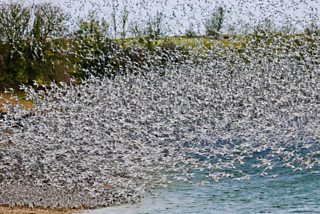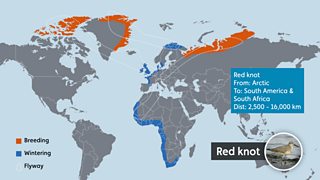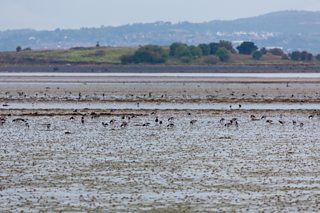Dumpy, drab, stocky… these are just some of the words used to describe the unassuming red knot. Yet this bird has a surprisingly impressive story that belies its appearance.
A knot means what?

Knot in breeding plumage WWT
Knots are sometimes known by their scientific name Calidris canutus, sometimes known as the red knot due to their rosy breeding plumage. Their scientific name is derived from the Danish king who failed to turn back the tide, King Canute. Say their common name with a hard ‘K’ and the connection is more obvious.
As you’ll see for yourself on Autumnwatch, there is a good reason for this name. As the tide comes in, hordes of birds are pushed back and rise up in their thousands. Sometimes flocks in excess of 100,000 have been recorded. Starlings are well known for their murmurations, yet knots are a sight to behold as they crowd along the shorelines of estuaries in vast groups during autumn and winter. Then they take to the skies in huge groups, wheeling and flashing the brilliant underside of their wings in unison against a low sun, sparkling like the flecks of light on the surrounding sea.

Flock of knots Steve Nicholls
An unexpected journey
Seeing them crowding along the tideline, you might be surprised by how far they’ve come, but these knots nest in the far north, often well above the border of the Arctic circle. There are about 215 different species of wading birds spread across the world, more than half of which migrate[. The knot has one of the longest migrations of any bird, with some species travelling all the way down to South America. They can be on the move for up to seven months of the year.
Why they come to the UK is still a bit of a puzzle. The knots we see here are usually birds who breed in Eastern Canada, yet instead of taking the arguably safer and quicker route down to the Gulf coast of the United States, they fly across the Greenland landmass, and over the chilly and stormy North Atlantic.

When crossing the ocean they’re unable to feed, so can end up travelling up to 3000km non-stop. It’s thought that these long journeys are a result of birds spreading out around the world but keeping their traditional migration routes, showing the importance of ingrained tradition for certain species. In a world where climates and habitats are changing with ever-increasing speed, there’s a question mark hanging over the future of our wading birds who rely so heavily on their known routes.
Adapted for coastal life
Knots are real marine birds in winter, thronging the shoreline because of the nutritious crustaceans, molluscs and shellfish that are found in estuaries. They often appear at WWT centres that include marine coastal habitat such as Strangford Lough, the Solway Firth and the Burry Inlet. The Wash in England has the largest concentrations of the bird. Their beaks are perfectly designed to stab into the mud and sensory organs at the end of their bills allow them to send out tiny vibrations and locate their prey through touch, rather than sight or sound – a useful adaptation for when your prey is hidden beneath your feet.

Strangford Lough Sacha Dench
Protecting the knot
Knots, like many of our migratory waders, are declining. They are listed as Near Threatened on the IUCN Red List, struggling due to a number of factors: increasingly unpredictable weather disrupting their migration, and the destruction of their wetland habitat meaning that they can no longer find suitable places to rest and feed in order to complete their gigantic journey. Often these birds are totally reliant on the estuaries that act as ‘service stations’ or safe places to spend the winter. That’s why at WWT reserves we spring into action as summer comes to an end, ensuring our coastal sites are sympathetically managed to provide the best possible winter sanctuary for exhausted migratory wading birds like the knot.
